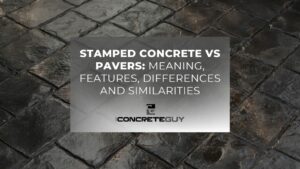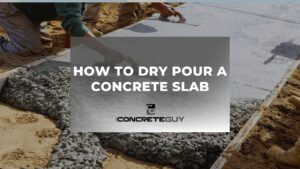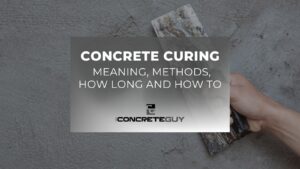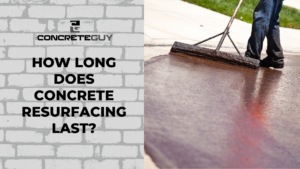According to the American Concrete Pavement Association, a concrete overlay, also known as a rigid pavement, consists of Portland cement concrete typically poured into slabs on a subgrade made of coarse packed dirt. Asphalt paving on the other is flexible and multilayered having different sublevels that give a springy and smooth pavement.
These two paving options are popular for different reasons. Factors such as traffic, weather, and use cases, affect how these pavement types perform. A major difference between the two is strength and how they distribute load to the subgrade. This is where the concrete overlay shines.
On the other hand, asphalt is not as expensive as concrete overlay, which makes it more cost-effective for people working on a budget.
What is a Concrete Overlay?
A concrete overlay is a thin layer of concrete applied over an existing surface, such as a driveway, patio, sidewalk, or floor. It is used to improve the appearance, durability, and functionality of the existing surface without the need for complete replacement of the original concrete.
Concrete is a hard rigid material made from sand, gravel, and cement. It is expensive but long-lasting and durable. It is the most popular choice of pavement because of its versatility and low maintenance. Because of its innate structural strength, a concrete pavement is less likely to get damaged by heavy traffic and large vehicles. It is also less susceptible to damage from extreme temperatures.
The constituents of concrete are also natural, hence a concrete overlay offers the extra advantage of being environmentally friendly. Furthermore, contractors consider concrete overlays a practical choice because they offer the opportunity to further enhance the pavement through texture, reinforcement, and color.
But what makes concrete overlays stand out from asphalt pavement, and indeed any other form of pavement, is its longevity. A concrete pavement outlasts other forms of pavement by 10 years before there is a need for maintenance or rehabilitation.
What are the Advantages of a Concrete Overlay?
A concrete overlay is a favorite among contractors because of the several advantages it has over other pavement options. Here are some advantages of a concrete pavement:
- Concrete pavements are durable. They are structured in such a way as to withstand extreme usage and weather conditions.
- Concrete pavements are versatile. Concrete is easy to mold, texture, color, and reinforce. This feature gives contractors the chance to create strong, long-lasting, and architecturally beautiful pavements
- Concrete pavements are cost-effective. Although it is more expensive than asphalt, concrete pavements are affordable, and because they require minimal maintenance, they are more cost-effective than other types of pavements.
- Concrete pavements are eco-friendly. Concrete is made from eco-friendly materials and has a long life span, making concrete pavements a sustainable and environmentally friendly option.
- Concrete pavements are energy efficient. Concrete is structured in a way that gives it excellent thermal mass. It helps regulate temperature and reduce general energy consumption.
What are The Disadvantages of a Concrete Overlay?
While concrete overlays are a favorite among contractors, they do have some disadvantages. Here’s a list of these disadvantages:
- Concrete overlay cracks over time. While it is durable and resistant to extreme weather conditions, a concrete overlay starts to crack after long use in unfavorable conditions.
- Concrete overlay offers limited flexibility. A concrete pavement offers some versatility; however, this versatility is greatly reduced after the concrete dries.
- Concrete production impacts the environment. While concrete is made from natural materials, the process of producing and transporting it is not as environmentally friendly.
What is an Asphalt Paving?
Asphalt is made from bitumen, a petroleum-based material, and aggregate. Asphalt pavements consist of a layer of asphalt poured over a base and subbase course, usually stone or gravel. Because asphalt is flexible, asphalt pavements are easy to install and easier to repair.
Asphalt paving is not as popular as concrete but its relative durability, longevity, and quick installation time make it a cost-effective option.
While asphalt does not do well with heavy usage, it is known to withstand extreme weather better than concrete, It is also easier to maintain.
What are The Advantages of Asphalt Paving
Asphalt is not as functional as concrete, but it has its benefits. Here are a few advantages to an asphalt pavement:
- Asphalt is smooth to drive on.
- Asphalt pavements are easy to maintain. They require less maintenance than other pavement options.
- Asphalt pavings are completed quickly. The materials for making them are also easily sourced. The process is easy too.
- Asphalt is durable. Pavements made from asphalt are resistant to extreme weather conditions and heavy traffic.
- Asphalt makes for quiet driving. It reduces noise pollution better than other pavements.
- Asphalt pavings improve safety because they offer better traction.
- Asphalts can be designed to meet limited aesthetic expectations.
What are the Disadvantages of Asphalt Paving
Here are a few disadvantages of laying asphalt pavement:
- Asphalt pavings are expensive to install. Repairing or replacing them is also not cheap.
- Asphalt pavings require regular repairs and maintenance.
- Asphalt pavings have short lifespans compared to concrete. After some time, complete removal and replacement becomes necessary.
How Do They Measure Up Against Each Other?
The table below compares these two pavement types to see how well they do against each other.
| Concrete Overlay | Asphalt Paving | |
| Climate | Wears down when subjected to extreme weather. | Adapts to changing climate easily. |
| Traffic | Great for foot traffic. | A better option for parking lots and highways. |
| Durability | More durable | Less durable |
| Longevity | Lasts about 27.5 years before needing repairs | Lasts about 15.5 years before needing repairs. |
| Installation | Installation is longer and more difficult. | Installation is not as long and not as difficult. |
| Maintenance | Requires less maintenance and lasts longer between each maintenance. | Requires frequent maintenance. |
Concrete Overlay Vs Asphalt Paving: Which is Better?
Concrete and asphalt are two of the most common paving materials. But choosing which is better boils down to individual needs. Asphalt is more affordable and is a better option for large projects than concrete. It is also a great option for regions that experience extreme freeze-thaw cycles. Asphalt pavings require frequent maintenance, but these are generally cheaper and easier to carry out than with concrete.
Concrete, while more expensive to install and maintain, is more durable. It is also the best option for cold climates as asphalt tends to crack when subjected to extreme drops in temperature. The longevity of concrete also makes it cost-efficient in the long run.
- Is asphalt paving suitable for both residential and commercial applications?
Yes, asphalt paving is versatile and can be used for various applications, including residential driveways, commercial parking lots, and roadways.
- How long does asphalt paving typically last?
With proper maintenance, an asphalt surface lasts anywhere from 15 to 20 years, depending on factors such as climate and traffic load.
- How long does it take for a concrete overlay to cure?
The curing time for a concrete overlay varies depending on factors such as temperature, humidity, and the type of overlay used. Typically, it can take several days to a week for the overlay to fully cure and achieve its maximum strength.
- Can decorative elements be incorporated into concrete overlays?
Yes, concrete overlays offer a high level of versatility and can incorporate various decorative elements such as stamped patterns, stained finishes, and exposed aggregates to enhance aesthetics and visual appeal.









